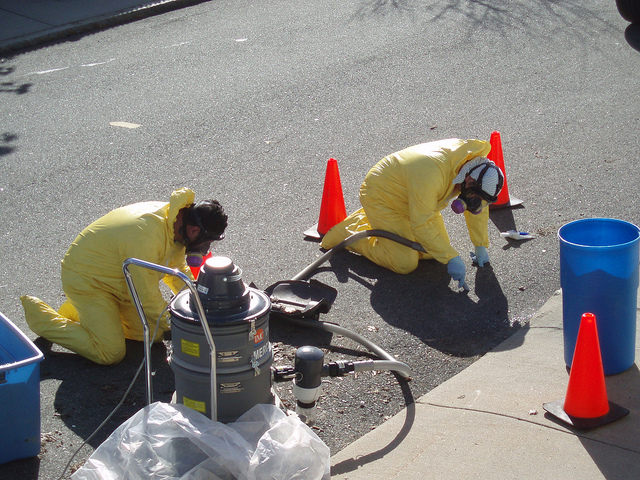OSHA regulates workplace air contaminants to protect employees from exposures to airborne chemical and particulate contaminants in workplace air. Generally, employee exposures are limited by permissible exposure limits (PEL) based on a time-weighted average (TWA) over an 8-hour workday. OSHA also allows exposure to some contaminants at greater “excursion limits” for short periods of time, subject to “ceiling values.” Many of these limits are based on voluntary standards developed by the American Conference of Governmental Industrial Hygienists (ACGIH).
Audit, Compliance and Risk Blog
Tags: Corporate Governance, Business & Legal, Employer Best Practices, Health & Safety, OSHA, Employee Rights, Environmental risks, Environmental, EHS, Hazcom
Exercise of Legal Powers By Director Constitutes Oppression of Minority Shareholders
Posted by Ron Davis on Wed, Sep 24, 2014
The decision by the Ontario Superior Court of Justice in Paul v. 1433295 Ontario Ltd. (2013 OSCJ 7002), illustrates that the oppression remedy is available to complainants, even when the actions that are the subject of the complaint are the result of a lawful procedure available under Ontario corporate legislation. The Court held that, although the procedure was lawful, the intent of the action was to squeeze out the affected shareholders and the results were oppressive to the minority shareholders’ interests.
Tags: Corporate Governance, Business & Legal, Internal Control, Canadian
BC’s Water Sustainability Act: What’s Coming Down the Pipe?
Posted by Zach Romano on Mon, Sep 22, 2014
Increasing demand on British Columbia’s water systems has highlighted the need for a flexible yet robust legislative framework that balances ecosystem health, water supply, and competition for resources. The BC government has taken a major step toward adaptive water governance with the introduction of Bill 18, the Water Sustainability Act (WSA).1 Although WSA is only a broad framework and the government deferred many important details to future regulations, water users should be aware of the key changes it makes to the existing Water Act2 and prepare for compliance with WSA when it comes into force during spring 2015.
Tags: Corporate Governance, Business & Legal, Health & Safety, Environmental risks, EHS, Canadian
Tornadoes can occur with little or no warning. Taking precautions in advance of the storms, such as developing an emergency plan, learning the warning signs, and monitoring tornado watches and warnings, can help you stay safe if a tornado occurs in your area.
Tags: Corporate Governance, Business & Legal, Health & Safety, OSHA, Training, EHS
Important Clean Air Act (CAA) elements direct the US Environmental Protection Agency (EPA) to reduce emissions of hazardous air pollutants (HAPs). Unlike the conventional pollutants associated with regional problems such as smog or acid rain, HAPs represent a list of 187 specific air toxics that can be harmful in low concentrations in much smaller areas. HAPs are subject to tighter controls and lower permitting thresholds.
Tags: Business & Legal, Health & Safety, Environmental risks, Environmental, EHS, EPA, Greenhouse Gas, ghg, Hazcom, mact
Internet Law: New Top-level Domains and Trademark Law
Posted by STP Editorial Team on Wed, Sep 10, 2014
Since 1998, generic top-level domain names (gTLDs) have been managed by the Internet Corporation for Assigned Names and Numbers (ICANN). Some of the more well-known gTLDs include:
Tags: Corporate Governance, Business & Legal, Internet, Intellectual Property
EPA May Require Spill Prevention, Control and Countermeasure Plan
Posted by Jon Elliott on Mon, Sep 08, 2014
The Clean Water Act (CWA), as amended after the Exxon Valdez spill by the Oil Pollution Act of 1990, imposes oil spill planning requirements on onshore and offshore facilities involved in the handling and transport of oil. These facilities may be required to prepare and implement a Spill Prevention, Control and Countermeasure (SPCC) Plan (and perhaps a more detailed Facility Response Plan). During 2001-2011, EPA adopted a series of significant changes to its SPCC Plan regulations, requiring compliance by most facilities no later than November 10, 2011.
Tags: Business & Legal, Health & Safety, OSHA, Environmental risks, EHS, EPA, Underground Storage Tanks
EPA Seeks Comments On Accidental Release Prevention Requirements
Posted by Jon Elliott on Thu, Sep 04, 2014
In August 2013, President Obama issued an Executive Order directing federal regulatory agencies to review specified regulatory programs that are designed to prevent catastrophic releases of toxics: Occupational Safety and Health Administration (OSHA) Chemical Process Safety Management Standard (PSM); Environmental Protection Agency (EPA) Accidental Release Prevention (ARP) program and Emergency Planning and Right-to-Know Act (EPCRA) program; and Department of Homeland Security (DHS) Chemical Facility Anti-Terrorism Standards (CFATS) program (I blogged about the EO here, OSHA’s consideration of PSM changes here, and about one of the agencies’ joint reports on progress here). EPA has just issued a request for information on the possible revisions to ARP requirements, which are described below.
Tags: Corporate Governance, Business & Legal, Health & Safety, OSHA, Environmental risks, Environmental, EPA
Production Company Cited for Safety Violations Causing Worker Injury and Fatality
Posted by STP Editorial Team on Tue, Sep 02, 2014
Tags: Corporate Governance, Business & Legal, Employer Best Practices, Health & Safety, OSHA, Employee Rights
Warm summer weather means increased holiday bookings, employees less inclined to stay late, and in some cases, lowered staffing levels. But an empty chair may not mean the employee is out just enjoying the sunshine; they may be taking any one of a number of leaves of absences.
Tags: Corporate Governance, Business & Legal, Employer Best Practices, Employee Rights, Canadian










